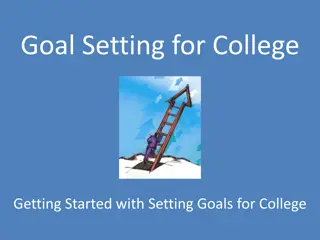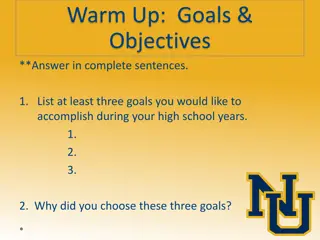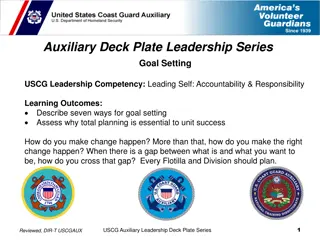The Importance of Goal Setting in Achieving Success
Setting clear goals is essential for success in both athletic endeavors and everyday life. Just like planning a road trip with a map, athletes need to establish long-term and short-term goals to guide their journey. Goal setting provides direction, feedback, and motivation, giving athletes a purpose in their training. Effective goal setting involves identifying both outcome and task goals, evaluating progress, and setting team and individual goals to create a roadmap for success.
Uploaded on Sep 17, 2024 | 0 Views
Download Presentation

Please find below an Image/Link to download the presentation.
The content on the website is provided AS IS for your information and personal use only. It may not be sold, licensed, or shared on other websites without obtaining consent from the author. Download presentation by click this link. If you encounter any issues during the download, it is possible that the publisher has removed the file from their server.
E N D
Presentation Transcript
Your Road Map to Success Excuse me, Sir, Alice inquires. Could you tell me which road to take? Wisely, the caterpillar asks, Where are you going? Somewhat dismayed Alice responds, Oh, I don t know where I am going, Sir. Well, replied the caterpillar, if you don t know where you are going, it really doesn t matter which road you take. (Alice in Wonderland Lewis Carrol)
Lets Take a Road Trip. Before we go anywhere, a little planning needs to be done. Where do we want to go? Let s drive from Green to Myrtle Beach, SC. How are we going to get there? Let s drive! What supplies are we going to need? Sunglasses, some money, snacks for the trip, CD s .. But, don t forget the map. The easiest way to plan for a trip is with a road map. When using a road map you are, in essence, setting goals for the trip. The road map can: locate specifically where it is you re going (long term goal), determine how many planned stops to take along the way (short- term goal), tell you how many miles to the next destination (daily goal)
Lets Take a Road Trip. tell you the alternate routes along the way, and help locate tourist stops en route (you should always enjoy the journey). Now, let s apply this to swimming. Similar questions should be asked of you as a swimmer before you take off on an athletic journey. Where will you want to be at the end of the season? What are you going to do physically and mentally in order to get there? What skills and tools do you need in order to reach their destination? This presentation will help swimmers and their parents plan their athletic journey with consistent use of goals.
How Exactly Does Goal Setting Help? Good goal setting gives an athlete an edge in three areas: 1. Goals provide direction. 2. Goals provide feedback. 3. Goals motivate; provide a daily purpose for doing well at workouts.
Basic Tips for Effective Goal Setting Identify both Short-term and Long-term goals. Identify task goals in addition to outcome goals. Act. Evaluate your goals. Set both team and individual goals
How Far Ahead Should an Athlete Look? Effective goal setting entails setting long- term and short-term goals; these goals will identify where the athlete is going and how they are going to get there.
How Far Ahead Should an Athlete Look? When planning a vacation, you often think about dream destinations. Where would you go if you had unlimited funds and abilities Egypt, the Caribbean, Europe? As with traveling and many other aspects of life it is fun to dream. In sport, it is also fun and important to dream. Dream goals allow you to project years into the future without any limits. For example, for many athletes making the Olympic Team is a dream goal.
How Far Ahead Should an Athlete Look? Athletes need to progress from a dream goal to a long-term goal. Long-term goals are typically one season to numerous seasons down the road; as in the road trip analogy, this goal is the destination.
How Far Ahead Should an Athlete Look? One way to determine a good long-term goal would be to have swimmers ask themselves the question where do I want to be at the end of the season or the end of high school or college? Examples of the answer to this question can be in terms of having an improved streamline by the end of the season, a goal time, making a specific time standard, or earning a spot on a junior or senior national team.
How Far Ahead Should an Athlete Look? In order to make the long-term goal seem less daunting, short-term goals are set. Short-term goals are set for shorter lengths of time than long-term goals, usually between two weeks and a month. Short-term goals serve as stepping-stones for the long-term goals. Setting short-term goals allow one to monitor success towards the long-term goals. A good question to have swimmers ask themselves is Where do I want to be at the end of this month?
How Far Ahead Should an Athlete Look? Finally, short-term goals can also often feel far off therefore something more within reach is needed to maintain focus and motivation. For these reasons it is also important to set daily goals. Daily goals are to be set every day in practice and in competition. Setting effective daily goals will help motivate and bring higher intensity to training. Daily goals can be set for both physical training and psychological skill development. A good question for swimmers to ask themselves is why am I getting in the water today?
Identify Outcome Goals and Task Goals Effective goal setting necessitates that athletes set both outcome and task goals. Most swimmers are good at setting outcome goals; an outcome goal is any type of goal directed at the result. Swimming outcome goals are set when an individual focuses on attaining a specific place at a meet, achieving a time standard or a personal best, or beating a teammate in practice. Outcome goals are hard to control because they depend on both the ability and skill of the swimmer and his opponents. However, the swimmer has more control over task goals because they depend on their skill and ability only.
Identify Outcome Goals and Task Goals Task goals are what the swimmer must DO (physically and mentally) in order to accomplish their outcome goals. Examples of task goals include being aggressive in and out of each turn, holding a specific stroke count and maintaining splits through an event. Last year, Jason placed second at Regionals in both the 100 and 200m fly. Regionals will start in 2 days and all Jason is talking about is winning both the events. He says, Nothing but first will be good enough. Because such a goal is out of his control, it would be more effective to get him focused on what he needs to do to win the events. He needs to focus on a powerful start, control through 75, then working his kick. If he can do this, the outcome will take care of itself.
Taking Action Effective goal setting must involve not just a road map but a strategy to keep the goals real on a consistent basis. Without much, if any, prodding from coaches, swimmers are already setting goals (especially outcome goals). When asked, athletes talk about goals such as wanting to swim a certain time, making cuts, improving a specific aspect or their stroke, and staying streamlined off the walls
Taking Action However, coaches need to help swimmers progress from setting long-term and short term goals to actually acting on these goals. For example, when Grace, a 10-year-old swimmer, gets in the water every afternoon for practice, one wonders if any of her goals are salient? Does she focus on her stroke during warm-up? Is she conscious of her body position as she pushes off the wall? Or, is she just swimming , merely in the water doing the workout that her coaches instructed her to do?
Taking Action Once a goal setting map had been established, the next critical piece is to keep the athlete accountable to these goals. Doing this is largely a matter of creativity and finding a means of accountability that will work for athletes. Some examples of ways to keep goals at the forefront so they are acted upon include: Complete weekly goal setting forms Developing a goal chart Write goals on visible items such as water bottles, kick boards or caps Verbalize goals to teammates, friends, family
Evaluate your Goals Effective goal setting requires athletes to regularly evaluate progress towards their goals, note successes along the way, and modify goals if necessary. Let s go back to the road map analogy, where the goal is to drive from Green to Myrtle Beach. Suppose you take off bright and early in the morning with your trusty roadmap in hand. On day one, your goal is to make it to Charleston, NC by sundown. However, outside of Fancy Gap, VI, there was an accident and you end up sitting on the interstate for 2 hours. At what point, if ever, will you stop to assess your progress and re-evaluate your goals?
Evaluate your Goals Back in the pool, Robert, the star distance freestyler on the team, developed a shoulder problem and only kicked for the month of September. At what point should he reassess his goal of improving his stroke rate? Robert will only be disappointed and frustrated if he only evaluates his training based on his original goal of improving his stroke rate.
Evaluate your Goals Goals are meant to provide direction, give feedback on progress and motivate. To ensure they serve this purpose, goals must also be flexible. It is necessary to evaluate goals at several points during the swim season. Set up specific dates for your athletes to monitor their success and to make changes if needed.
KEY POINTS TO EMPHASIZE WHEN INTRODUCING GOAL SETTING TO SWIMMERS Ask swimmers to define GOALS. Have them discuss why they set goals. Discuss additional ways that goals can help performance. Teach swimmers the importance of Systematic Goal Setting using different lengths and types of goals give examples of elite athletes to stress the point
KEY POINTS TO EMPHASIZE WHEN INTRODUCING GOAL SETTING TO SWIMMERS Discuss, in detail, the tips of effective goal setting. Have the swimmers complete some of the goal setting exercises. Brainstorm ways for the team to stay on top of the goal setting plan.
FACILITATING INDIVIDUAL GOAL SETTING Here is a brief and simple process for facilitating goal setting for swimmers who have the cognitive ability to set goals, usually starting at about age 12 or 13. Younger swimmers generally do not have the cognitive ability to do meaningful goal setting. Meet with the swimmer individually to listen to his or her hopes and dreams Ask the swimmer to identify one to three events to set specific goals Review current best times Negotiate a specific goal time and target date for each chosen event Write down these times and post them where the swimmer and others will see them
FACILITATING INDIVIDUAL GOAL SETTING Figure out and write the specific splits needed to meet each goal time List several process goals needed to achieve each goal time. These might be times to hold on practice sets or skills that must be maintained during practice. Ask the swimmer to list what he or she needs from the coach to accomplish the goals Ask the swimmer to write his or her process and outcome goals and post them where the swimmer will see them often Look for and recognize workout performances that can be related to process and outcome goals Review process goals regularly with the swimmer
FACILITATING INDIVIDUAL GOAL SETTING Because of individual differences, athletes will probably develop different goal-setting strategies. What is important is that they develop and use a system that works for them; it needs to be a system to which they will adhere that also incorporates the basic principles of effective goal setting. Through adherence to systematic goal setting, athletes can tolerate setbacks or barriers because they have a clear focus on long-term goals and confidence in their ability to reach these goals.
FACILITATING INDIVIDUAL GOAL SETTING Obviously, athlete goals will be individualized, but they should also fit within established team goals. Setting goals implies that the swimmers should progress from their present state or ability to a targeted state or ability. The goals the coach and swimmers set should correspond to the seasonal plan the coach develops for the team or training group.
FACILITATING TEAM GOAL SETTING Team goals are vitally important to the growth of a program. Goals can be set for competition, team size, workout performance and even social activities. In setting competition team goals it is best to involve the team thereby making the goals team goals and not just the coach s goals for the team. Here is a brief process for setting team goals for a high school aged team. The coach: Reviews past results
FACILITATING TEAM GOAL SETTING Looks at current roster Looks at strengths and weaknesses Predicts improvements Sets a goal, for example: Top 3 at Sectionals. The coach then considers what it will take to achieve that goal. For example: What does it take to be top 3?
FACILITATING TEAM GOAL SETTING How many points? How many scoring relays? How many finalists? What events are strongest for the team?
FACILITATING TEAM GOAL SETTING What events need the most work to improve? (This is also a great basis for creating a season training plan.) Next, the coach holds a team meeting and asks, What should our team goal for this season be? By asking the right questions and giving enough information, the coach can get the team to come up with team goals that very closely match his or her goals except that now they are TEAM goals. The coach can then put some swimmers in charge of recording both the process (workout) goals and the outcome goals, making copies, and distributing to the entire team.
The Process of Goal Setting Goal setting may be the most important task a swimmer has during a season. Goals tend to give purpose and direction to a swimmer s effort. Goals give the swimmer a reason to put forth the effort in workout. A goal can be either short range or long range. Short-range goals can be stepping stones toward a long-range goal. For example, making a sendoff never before accomplished can lead to making a better time at a meet or reaching a higher level of competition.
The Process of Goal Setting No matter how novice or how experienced the swimmer, goal setting is still important. A person who has just begun swimming may have a goal of doing one length of legal breaststroke whereas the person who has swum a few years may want to make YMCA Zones. Each goal is just as great an accomplishment as the other.
The Process of Goal Setting Goal setting should be personal for each swimmer. The coach does not set a swimmer s goals. Only the swimmer can set his/her goals. The coach can only give guidance and direction toward an appropriate goal. A goal must be realistic yet require a certain amount of effort to achieve. The tougher the goal, the greater the dedication required and the greater the satisfaction when it is achieved.
The Process of Goal Setting A swimmer should set goals that are realistic. A swimmer should strive for League standards before setting a goal for YMCA Zone standards which are much more difficult. Making zone standards is a good long- range goal, but the swimmer s first goal should be to make the League Meet. You must learn to walk before you can run
The Process of Goal Setting Be careful not to set a goal that is dependent on someone else s performance. In other words, to set a goal to be as fast as one of the other competitors is not good. The problem is that the swimmer may improve continuously yet not catch this person. Therefore, the swimmer may be disappointed when even though he is doing tremendously well. However, this is not to say one should not have a healthy rivalry. This can be a rewarding part of competition.
The Process of Goal Setting There are a wide variety of goals that make it possible for swimmers at every level of competition to have something to work toward. Attaining a goal is a gradual process and if a swimmer can work to improve a little at each workout and drop time a little each time they compete, the swimmer will reach the goal.
Goals are ongoing Goals should be realistic Having said that, one should look beyond what one considers possible. Ask yourself, when I achieve my goal, then what? Too many times, we see swimmers make the State HS Meet only to have sub par swims there. They achieved their goal but didn t know what to do next.
Goals are Ongoing Keep in the back of your mind goals beyond what you want to achieve When I make Zones, I want to score. When I score, I want to score in the top 10. When I score in the top 10, I want to medal. When I medal, I want to win. When I win, I want to qualify for Nationals. Etc.
The Process of Goal Setting In workouts, each swimmer has the chance to challenge himself; to work that little bit harder that may make the difference in the race. In workouts, a swimmer can always be trying to do something that he has never done before. As a swimmer makes these steps in workouts, they are also making steps toward goals they may have for competition.
The Process of Goal Setting Without a goal, swimming can tend to be just going up and down the pool. With a goal, the swimmer has a driving force that will take him to higher levels of competition while developing the goal-setting skills and accompanying discipline for diverse applications in later life.
The Process of Goal Setting Everyone on the BARRACUDAS Swim Team is a Winner! The discipline, training, enduring friendships, and competition are rewards in themselves. In the end, a swimmer is competing against himself. As I like to say, you have to win your own lane, first.























